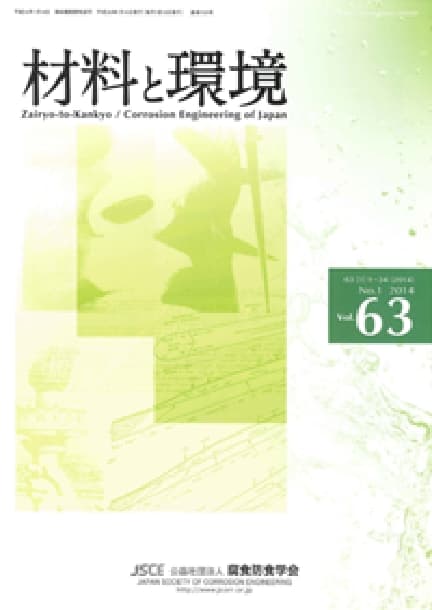- TOP
- Zairyo-to-Kankyo
- Vol. 58 (2009), No. 1
Zairyo-to-Kankyo Vol. 58 (2009), No. 1
Backnumber
-
Vol. 74 (2025)
-
Vol. 73 (2024)
-
Vol. 72 (2023)
-
Vol. 71 (2022)
-
Vol. 70 (2021)
-
Vol. 69 (2020)
-
Vol. 68 (2019)
-
Vol. 67 (2018)
-
Vol. 66 (2017)
-
Vol. 65 (2016)
-
Vol. 64 (2015)
-
Vol. 63 (2014)
-
Vol. 62 (2013)
-
Vol. 61 (2012)
-
Vol. 60 (2011)
-
Vol. 59 (2010)
-
Vol. 58 (2009)
-
Vol. 57 (2008)
-
Vol. 56 (2007)
-
Vol. 55 (2006)
-
Vol. 54 (2005)
-
Vol. 53 (2004)
-
Vol. 52 (2003)
-
Vol. 51 (2002)
-
Vol. 50 (2001)
-
Vol. 49 (2000)
-
Vol. 48 (1999)
-
Vol. 47 (1998)
-
Vol. 46 (1997)
-
Vol. 45 (1996)
-
Vol. 44 (1995)
-
Vol. 43 (1994)
-
Vol. 42 (1993)
-
Vol. 41 (1992)
-
Vol. 40 (1991)
Keyword Ranking
07 Dec. (Last 30 Days)
Zairyo-to-Kankyo Vol. 58 (2009), No. 1
A Nanotechnology in Corrosion Science (Part 4)
Kunitsugu Aramaki
pp. 3-11
DOI:
10.3323/jcorr.58.3Abstract
A self-assembled monolayer (SAM) of p-hydroxymethylbenzene moiety adsorbed on iron by the formation of a covalent bond between iron and carbon atoms was prepared by electrolytic reduction of diazonium ion. Ultrathin polymer films of the SAM were prepared on the iron surface by chemical modification with alkylethoxysilanes. The protective abilities of the films against iron corrosion were examined by polarization measurements in an aerated 0.5 M NaCl solution. High protective performances of the films were obtained after immersion in the solution for many hours due to the formation of a strong adsorption bond.
Effect of Alloying Elements on Corrosion Behavior of Stainless Steels in High Temperature Chloride Environment
Nobuhiko Hiraide, Kajimura Haruhiko
pp. 20-28
DOI:
10.3323/jcorr.58.20Abstract
Effect of alloying elements on corrosion behavior of austenitic stainless steels in high temperature chloride environment was investigated by hot corrosion test. The test was cyclic test of dipping in NaCl aqueous solution at room temperature and heating in air at 500–700°C. The main corrosion element was Fe and the main corrosion products was α-Fe2O3. Over 70 percent of corrosion products of Cr existed as Cr2O3 and (Fe, Cr, Ni)3O4 on the specimen surface, and Cr2O3 was not protective. The rest of corrosion products of Cr dissolved in NaCl aqueous solution. Si improved the corrosion resistance remarkably by concentrating as stable Si oxide at the interface between parent metal and corrosion products. Ni and Mo were also effective elements on improving the corrosion resistance.
Readers Who Read This Article Also Read
Tetsu-to-Hagané Vol.48(1962), No.11
Tetsu-to-Hagané Vol.46(1960), No.3
Degradation Evaluation of Protective Coatings by Scanning Acoustic Microscopy and Current Interrupter Method
Tsuyoshi Matsumoto, Toshikazu Niinai, Isao Sekine
pp. 29-32
DOI:
10.3323/jcorr.58.29Abstract
Coating degradation has been generally evaluated by its surface appearance by visual observation. However, it is impossible to evaluate the inside of the coating, and corrosion beneath coating by the visual observation. The coating evaluation methods by the Scanning Acoustic Microscope (SAM) and the current interrupter method (CI) as the quantitative coating evaluation method with non-destructive technique are discussed. It was found that the SAM can quantitatively detect the interlayer blisters between coating films which were not detected by visual observation, while the CI method can not quantitatively detect the interlayer blisters between coating films. The correlation of SAM and CI was not able to obtain from this experiment.
Article Access Ranking
07 Dec. (Last 30 Days)
-
Perspectives on the Promising Pathways to Zero Carbon Emissions in the Steel Industry toward 2050
ISIJ International Vol.65(2025), No.2
-
Factors Influencing the Bonding Phase Structure of Iron Ore Sinters
ISIJ International Vol.43(2003), No.9
-
Effect of microstructural heterogeneity on fatigue limit of as-quenched low-carbon low-alloy martensitic steel
ISIJ International Advance Publication
-
Delayed Fracture Mechanism of 1700 MPa-Class Quenched and Tempered Bolt under Atmospheric Corrosion Environment
Tetsu-to-Hagané Advance Publication
-
Progress of Strip Casting Technology for Steel; Historical Developments
ISIJ International Vol.52(2012), No.12
-
Research Progress on Optimal Blending of Iron Ore Powders for Sintering
ISIJ International Vol.65(2025), No.12
-
-
Microstructures and Reduction Properties of High CaO Concentration Sintered Ore
ISIJ International Advance Publication
-
Influence of Antimony on the Oxidation Characteristics of 65Mn Steel
ISIJ International Advance Publication
-
Mechanism of Ammonium Thiocyanate Decomposition Driven by Electrolytic Hydrogen Charging
Zairyo-to-Kankyo Vol.74(2025), No.2
You can use this feature after you logged into the site.
Please click the button below.










